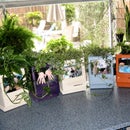Introduction: Building an Hexagonal Acrylic Aquarium
Here's a fishtank I built to fit inside an old oak coffee table I found at a flea market. It's not a simple build, but I managed to figure it out mostly by myself with little prior experience. Here's how I did it.
Step 1: Materials and Tools
I started with the oak end table and some acrylic sheet from Home Depot. The acrylic tube came from a plastics wholesale business. Have as much of the acrylic pre-cut as possible. When I need to cut acrylic, I use a jigsaw with a plastics blade. You'll also need a propane torch and an acrylic solvent called methylene chloride.
Cutting a straight line along edges that will be watertight is really important. Cut and file edges smooth and you'll be rewarded with a tank that won't leak. I find it useful to build cardboard models of my tanks and then use them as templates for my acrylic.
Step 2: Bending Acrylic
An acrylic hex tank is just 2 pieces of acrylic. One for the base and one long piece for the sides. This piece will have 5 bends and 1 seam.
Because the base is already cut to the exact size and shape for the tank, I will make each bend fit the base. Because the acrylic is flexible, exact precision is not required. Nonetheless, we want to make our bends as square as possible.
Clamp the acrylic so that the bend just overhangs the edge of the bench and heat it with a propane torch set to a medium flame. Keep the torch moving! You want to soften the acrylic but not melt it. If you see bubbles, or if a lick of flame is left behind when you move the torch, then you're getting the material too hot.
Once the bend forms, take the clamps off and set it on the base. You'll have a couple minutes to get the bend at just the right angle. Hold it for 3 or 5 minutes and it will cool and harden in place.
After it cools, mark the spot for the next bend with a Sharpie.
Step 3: More Bending
Keep bending, marking the next bend after the bend before it cools. The key is to keep the bends square so check the position carefully as you clamp the piece before each new bend.
Step 4: The Last Bend & Joining the Seam
On my bench at least, there's no room to make the last bend. I had success heating that line and then improvising the bend as best I could once it was placed on the base. Note the overlap in the second picture. We need to get rid of that next.
Clamp the tank to the base. The goal is to find an exact mark where the excess needs to be trimmed, both top and bottom. Use painter's tape on both sides of the acrylic to minimize chipping and cut. I tried to cut a bevel edge that would hopefully mate with the bevel I'd previously cut on the other end. It worked pretty well considering the lack of precision involved.
Once the piece is cut, I tape it so that it fits the base. FIrst, a lot of tape on the outside while I applied thickened solvent into the seam. Then, turn it over and apply to the outside of the seam. This worked very well for me, I never had even a single drop leak.
Step 5: Attach the Base & Light Tube
It's time to attach the tank sides to the base using the acrylic solvent. I had precut a hole in the base piece with the jigsaw. I used the thickened solvent to fill the seam both top and bottom. The tube extends comfortably above the water line.
Step 6: Test With Water
If your edges are smooth and your bends are square and your bonds are strong, it'll hold water for many years. I can't promise you success, but I've had great luck just taking my time and practicing on scrap pieces. My experience has been if it holds water for 24 hours, it'll hold water forever.
The light fixture is a 12" florescent fixture with an aquarium spectrum bulb. I built a little stand fro scrap acrylic to hold it up with reach. It lights the tank wonderfully.
Step 7: The Finished Aquarium
And here is the finished tank, ready to add fish.












